2019 Activity Report
March Activity Report
31 March 2020
Global Japan Office Coordinator
HARA Masaki
【University Closure】
The University of Lviv had regular classes until Wednesday, March 11. However, following the government’s decision announced on the same day to close all universities and schools from the next day, the University has been closed since Thursday, March 12. At the time, Ukraine had only one confirmed case of infection with the novel coronavirus, so I was a little surprised by this measure. From the afternoon of the 12th, we were not allowed to enter the campus. Some teachers started to offer online classes.
Schools (equivalent to Japanese elementary, junior high and high schools) have also been closed, and the mock examination of the Center Examination (External independent evaluation or ЗНО) initially scheduled for March was postponed until early April, and has now been postponed further. The decision whether to hold the mock exam at all will be made by April 24. According to the Ministry of Education, the actual Center Examination will be rescheduled to a later date than usual this year (in Ukraine, the Center Examination is the unified university entrance examination). Students and their parents must be anxious because they do not know when they will be able to take the exam, or if the fees already paid will be refunded if the mock examination is canceled.
【Quarantine Measures】
In Ukraine, to prevent the spread of the new coronavirus, three-week “quarantine measures (карантин)” were implemented on March 12 until April 3. Subsequently, these measures were extended until April 24, and an “emergency situation (надзвичайна ситуація)” was declared nationwide. During this period, Ukraine’s borders are closed and all foreigners except those with permanent residency or temporary residency status, diplomats and staff of international organizations, are prohibited from entering. An “emergency situation” is explained as different from a “state of emergency” and no measures have been taken to restrict the rights of individual citizens. I think the “quarantine measures” are like the lockdown that has been recently talked about in Tokyo. Enforcing lockdown in Ukraine seems relatively easy once transportation between cities is stopped, as Ukrainian cities, towns, and villages are scattered relatively far from each other. At the moment, private cars have not been stopped in many states.
One of the main focuses of the quarantine measures is the blockage of the transportation network, which led to the suspension of regular international flights implemented on March 17. This was followed by the suspension of all domestic passenger transport including trains, buses, and flights on the 18th. Since then, special flights were operated by Ukraine International Airlines, SkyUp Airlines, and other domestic and international airlines to transport Ukrainian nationals abroad seeking to return to Ukraine and foreigners in Ukraine seeking to leave Ukraine. However, all these flights were suspended on March 27. There seems to be some passenger flights operating after that, but they may all be chartered flights, I am not sure of the details (“special flights” here refers to passenger flights in which an individual can purchase a ticket, while “chartered flights” are flights in which an individual cannot normally purchase a ticket.)
Some local public transportation has also been suspended or reduced, and they have been limiting the number of passengers allowed aboard at one time (I’m not sure if they’re following through with this – I once saw the police inspecting a bus, but I don’t have accurate information about the restrictions). Subways are out of service in the cities of Kyiv, Kharkiv and Dnipro, which were apparently the only precautionary measures in Europe until Georgia suspended its subway operations on March 30. It seems that Lvivelectrotrans Transportation is operating normally, though they have imposed a limit on the number of passengers and suspended the fare exemption for children and the elderly as well as the sale of tickets onboard. Buses are operating with reduced numbers (I suppose these changes have more to do with profits than precautions against infection; it would not be profitable to operate the regular schedule with a sharply decreased numbers of passengers, but I do not know for sure. I have the impression that the public transport services operated by public companies are keeping more lines running than those operated by private companies, though I have not investigated this either). There are usually a lot of buses for suburban routes in front of the station, but now only a few can be seen. At the station, there are trains and diesel railcars lined up, but the combinations seem to differ depending on the day. Passenger transportation has since been stopped and all trains are supposed to be suspended, but I wonder if commercial trains are still running. I once saw three latest-model trains lined up, but the number decreased to one the next day. And when I saw it on the 30th, there were no new trains any more, only conventional ones.
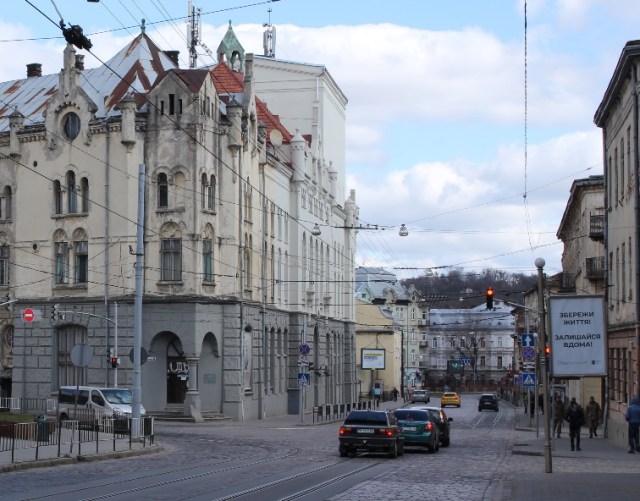
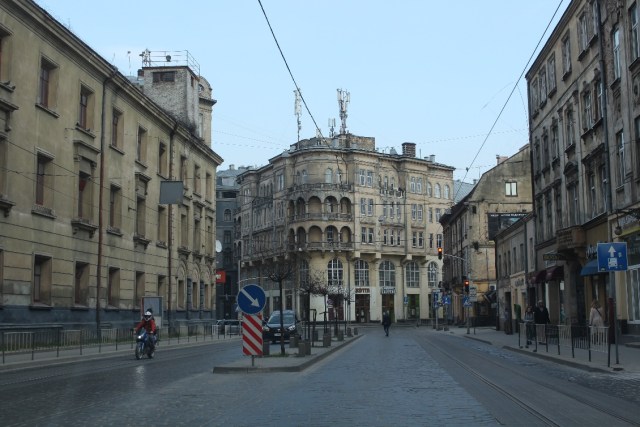
Another key to preventing the spread of infection is the closure of stores and public facilities. Stores other than grocery stores (including supermarkets), pharmacies, and gas stations were ordered closed. In shopping malls, only the supermarkets are open. It seems that the number of open stores is gradually decreasing. Some stores have shortened their business hours. At the moment, there is no shortage of products due to buyouts or disruptions in distribution, but people think it is only a matter of time. I wonder if this really is the case. Public services such as government offices have also been reduced. In Ukraine, people used to think that only seriously ill people wear masks, and people would give up their seat for those wearing a mask on a train or bus, but now the number of people wearing masks has greatly increased. However, some people do not wear masks due to supply shortage, or simply because they do not think them necessary. In any case, I feel sorry for them because they look uncomfortable wearing masks. Some people wear masks but leave their noses outside of them.
Governments and municipalities have called on citizens to stay indoors. They put out advertisements and broadcast announcements by driving cars fit with speakers around the city to raise awareness on the precautions. The city of Lviv is also relatively empty, as is Horodotska Street, which is always heavily congested. I heard that it was like this in the ’80s. I feel that the air has also improved. On another note, I hear that the city of Lviv is offering a service to look after the pets of infected persons (pre-registration required).
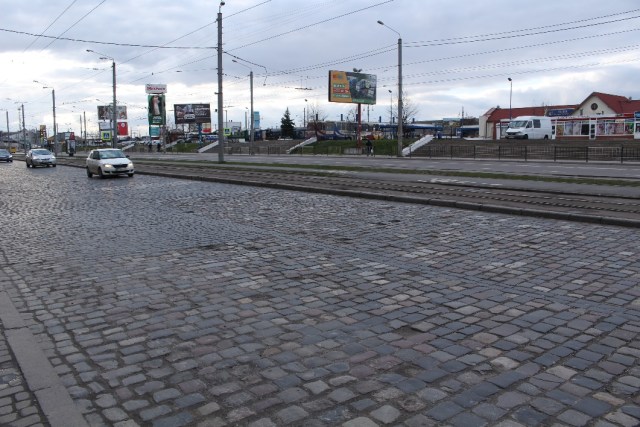
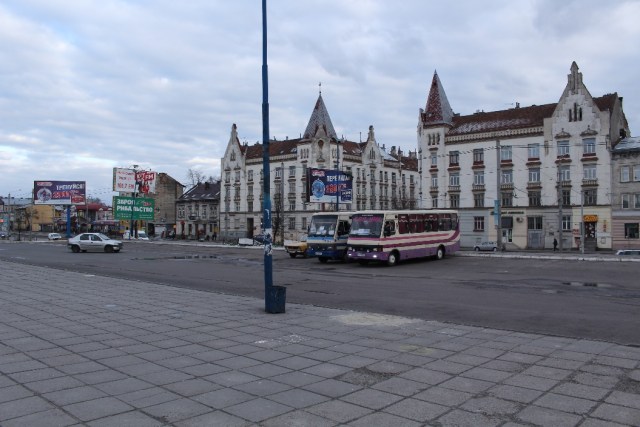
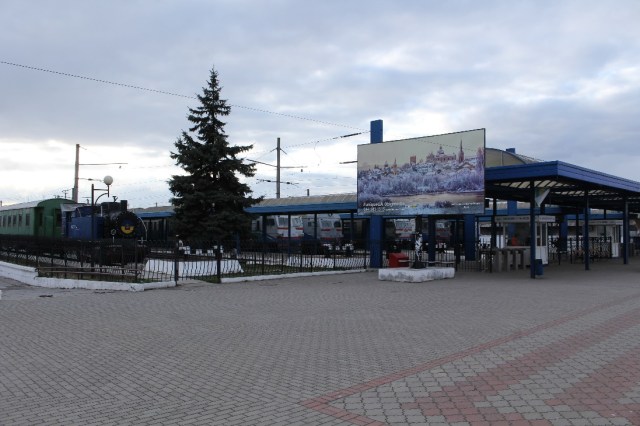
There is no knowing what will happen in Ukraine by the time this story is published on the website, but doctors in Lviv say Ukraine will follow the path of Italy. However, I think that Ukrainians always prefer to talk pessimistically about tough situations, and that this is part of their national character, so I hope that this situation doesn’t actually get that bad.
【Resources】
新型コロナウイルス感染者数等に関するデータ
https://www.pravda.com.ua/cdn/covid-19/cpa/
2020年3月31日閲覧(以下同じ)
新型コロナウイルス感染者数および分布
https://public.tableau.com/profile/publicviz#!/vizhome/monitor_15841091301660/sheet0
検疫措置実施の決定(ウクライナ政府)。2020年3月11日13:43
https://www.kmu.gov.ua/news/uryad-prijnyav-nizku-rishen-shcho-mayut-ubezpechiti-ukrayinciv-vid-covid-19-11-03-20?fbclid=IwAR31alZLy55xNAlW82qQAhLH1fKbFxzPtG-YtR5XDvuNj-1CJIagF-_Q6Bs
国際航空旅客輸送の停止(報道)。2020年3月13日20:14
https://www.pravda.com.ua/news/2020/03/13/7243562/
旅客輸送停止の決定(ウクライナ政府)。2020年3月16日00:12
https://www.kmu.gov.ua/news/uryad-prijnyav-rishennya-pro-zaboronu-pasazhirskih-perevezen-ta-obmezhiv-kilkist-uchasnikiv-masovih-zahodiv-10-osobami?fbclid=IwAR1eWu-SvtQysV484eHUFM73zPdS0B9klXeZscm_NEJBS9ah_O31Z8BiI94
検疫措置の4月24日までの延長(報道)。2020年3月25日13:44
https://www.pravda.com.ua/news/2020/03/25/7245063/
検疫措置の4月24日までの延長(日本国外務省)。2020年3月26日
https://www.anzen.mofa.go.jp/od/ryojiMailDetail.html?keyCd=84292
日本国外務省のウクライナに関する安全情報
https://www.anzen.mofa.go.jp/info/pcinfectionspothazardinfo_182.html#ad-image-0
リヴィウ市長アンドリーイ・サドヴィーイ氏のfacebook
(リヴィウ市の新型コロナウイルスに関する情報を提供している)
https://www.facebook.com/pg/andriy.sadovyi/posts/
December Activity Report
31 December 2019
Global Japan Office Coordinator
HARA Masaki
【State of the University】
Lviv University’s first semester classes ended on December 10. After that, students entered the period of final exams, though we still had a few classes during that period.
The final exams are either Zalik (exams with 3-level grading) or Ispyt (exams with 5-level grading). Zalik are often calculated from the students’ class participation. According to students, the final examinations can be either an exam (usually oral) or a report, similar to the exams in Japan.
【Skelivka】
This is a continuation of last month’s story.
Skelivka (Скелівка) is a village in the Staryi Sambir Raion in the state of Lviv.
This village was the home of the Herburts, and was previously known as Felsztyn (Фельштин) or Fulsztyn (Фульштин). The former name is said to have come from the fiefdom of the ancestors of the Herburt family in Germany. There is another town in Ukraine called Felsztyn, and it was also built by the Herburt family.
Felsztyn first appeared in the literature in 1390. In 1551, the Magdeburg rights were implemented in this village (therefore, Felsztyn must have become a city, but it is often referred to as a town). There used to be a city hall and a castle in the town, and the town was surrounded by castle walls. However, the original castle that Herburt built was destroyed in 1649.
Along the road stands St. Martinus’s Brick Church. It was erected by Jan Herburt around 1500 (There are a number of people named Jan Herburt. I think this Jan Herburt is the grandfather of Jan Szczęsny Herburt.). With thick walls and tall towers, the Herburt family temple once defended the town along with the castle.
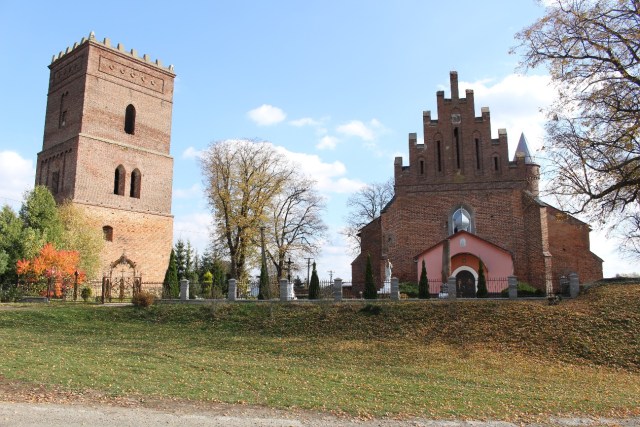
Today, the building, or at least its exterior, looks relatively well-preserved. However, it was once destroyed by the Russian Imperial Army during World War I and has not been restored to its original state since then. The roof has been changed from tiled to galvanized iron, the size of the turrets has been reduced and the interior and exterior decor has been lost. Perhaps the greatest losses were the destruction and loss of the Mannerism-style altars built in the 17th century and the Herbldt family graves. Even so, the exterior walls of the 16th century cathedral, the somewhat broken 15th century bell tower (a rope is attached so that the bell can be rung without entering the broken interior) and the defensive earthen walls all remain.
The school by the church seems to be there from olden times. The building has been rebuilt, but old pictures show the original school building standing there.
In the heart of the town near the bus stop is a park (former site of the city hall), opposite which stands the statue of Švejk. He is the main character of the novel “The Good Soldier Švejk” by Jaroslav Hašek (1883 – 1923), and his adventure started in the town of Felsztyn.
He went north from here to Dobromyl, where there is also a monument. He seems to be the “local celebrity” of this area.
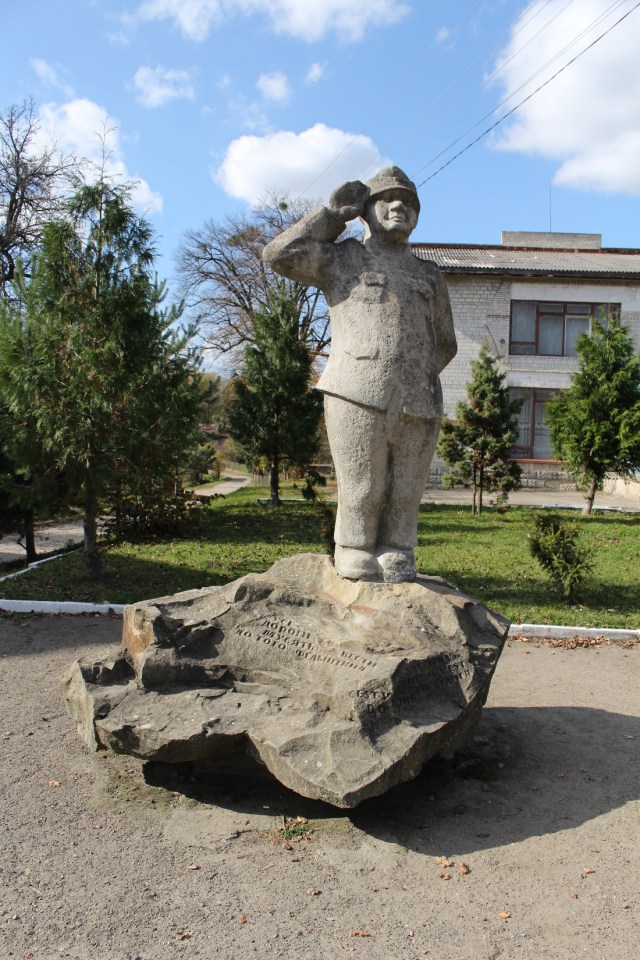
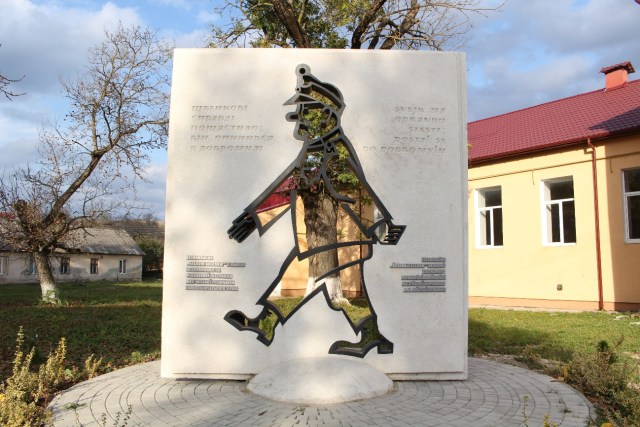
There used to be a synagogue, but it no longer exists. The Jews in this area were persecuted by the Nazis during World War II. At the site of the Jewish cemetery on the hill of Dobromyl, there is a monument made from their gravestones.
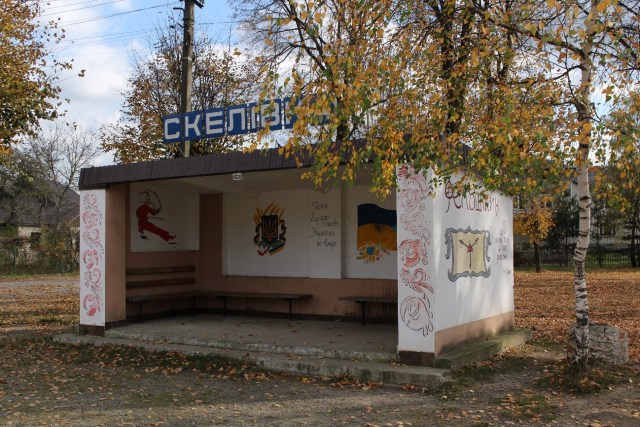
【Ternava】
Walking from Skelivka to Dobromyl, you will come across Ternava Village (Тернава). I don’t have proper materials for this village, but Wikipedia says it first appeared in literature in 1374. The quickest way to the Dobromyl Castle is to climb from this village. Turn right at the village cemetery, go through the fields, and you will reach the promontory.
This village can be said to be a typical Ukrainian agricultural village developed alongside the road. There are fruit trees in every house. The road meets a highway where buses pass. The other side of the road is another village.
There was a memorial cross in front of a house in the village. The plaque reads “Here, the brave soldiers of the Ukrainian Insurgent Army, Yaroslav Voitechko, Yaroslav Labinets, and Mykhailo Krasota fell. Glory to Ukraine, Glory to the heroes.” A record says that Voitechko was killed here on February 26, 1948 in a battle against the Soviet Interior Ministry.
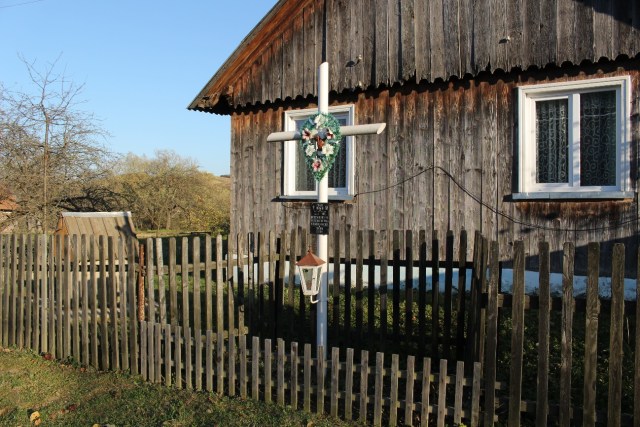
The Ukrainian Insurgent Army was an armed group and one of the most powerful of Ukraine’s numerous independence organizations that fought the most fiercely against the enemies of Ukraine’s independence. Organized in 1942 during the invasion and occupation of Ukraine by the Soviet Union and Nazi Germany, it operated throughout Ukraine (in the East and the South.).
During World War II, they fought against the Soviet Union, Germany, and Polish organizations that had collaborated with Germany. After the war, they fought against the Soviet Union and its satellite state, Poland. Their activities were supported by local residents, and, especially in the mountains of the west, they engaged in effective guerrilla warfare by hiding in the mountains and forests along with the villagers. Frustrated by this, the Soviet Union and Poland devised a way to eradicate the Ukrainian community at the root of the Ukrainian Insurgent Army and forcibly relocated non-combatants of Ukrainian origin. This ethnic cleansing policy was “Operation Vistula”.
I mentioned last month that Dobromyl is in the Boyko region, one of the areas most affected by this operation. The Ukrainian community was destroyed, and the isolated Ukrainian Insurgent Army, which had lost its support, gradually declined and was forced to abandon its systematic armed struggle in the mid-1950s.
The Battle of Ternava was one of several battles that took place in the core areas of Operation Vistula, which began in the spring of 1947. This memorial cross was probably built by the residents to mourn the tragic deaths of the young people.
【References】
Добромиль // Замки і храми України [https://castles.com.ua/dobromyl.html] (最終閲覧日:原稿作成日、以下同じ)。
Скелівка // Там само [https://castles.com.ua/skeliwka.html].
Давній Фельштин костел святого Мартина і не тільки [https://risu.org.ua/ua/relig_tourism/krayeznavstvo_digest/70334/].
Мацюк О. Замки і фортеці Західної України. Львів: Центр Європи, 2005. C. 83.
November Activity Report
30 November 2019
Global Japan Office Coordinator
HARA Masaki
【Lviv University This Month】
Very different from last month, where there were many events both inside and outside of the university, this month was classes as usual. We’ve been putting out efforts into studying Japanese, but there’s nothing particularly new that I’d like to mention here, so this time I’d like to talk about a town near Lviv.
【Dobromyl in the Boyko Region】
In this month’s report, we will take a look at Dobromyl, the hometown of Roman Romanovich Hamada (1961 – 2017), a professor of Oriental studies at the University of Lviv, where the GJO is based. He has unfortunately passed away, but he left many translations of Persian literature.
The city of Dobromyl is in the mountains southwest of Lviv, close to the Polish border. Around it, there are many mountains. From Lviv, it takes about 3 to 4 hours one way by train or bus via Sambir.
The area stretching over the territory of the present Republic of Poland is called Boikivshchyna, where the Boykos (a subgroup of Ukrainians), who speak a dialect of Ukrainian called Boyko, live (Dobromyl also overlaps with regions that speak the Upper Sannian dialect). This region is also the home of Ivan Franko. Boykos were persecuted by the Polish and Soviet policies of forced resettlement (Operation Vistula). Now, a monument commemorating the displaced stands in the square in front of Sambir Station.
【Dobromyl and the Herbrids】
Dobromyl first appears in historical documents in 1374. This was the year it was given by the Duke of Opole, Władysław, along with the villages of the Vyrva and Strviazha river valleys, to the Herbldt family of Westphalian ancestry.
It was originally a village, but by 1497 it had become a town with the permission of the king, and merchants from Moravia, Hungary, and Silesia gathered there. The town prospered as a salt manufacturer, and in 1566, thanks to the efforts of Stanislaw Herbert (1524 – 1584), the keeper of the castle, the town became a city through the Magdeburg Law (rights of an autonomous city) granted by the King. Even today, there is a landmark demonstrating the city’s autonomy; a splendid city hall in the central square.
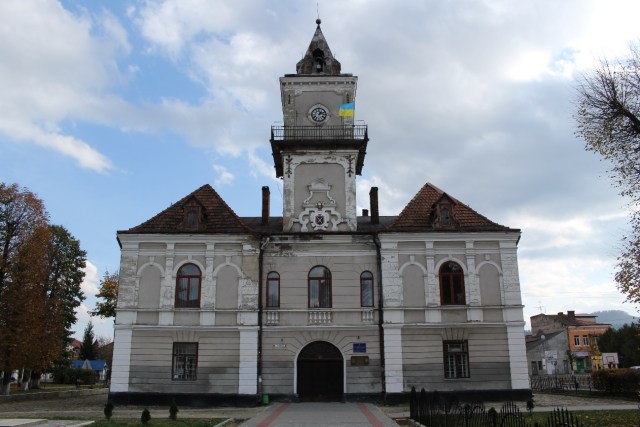
By the way, between the city and Mt. Chernecha, there was a village called Huchok (though it is now part of the city), which according to local lore was damp and had a waterfall. The village was named for the sound of the waterfall (Fuchu Fuchu). This name sounded so unsophisticated that it was not chosen when it became a city.
Andrzej Herburt founded the first Catholic church in this town, the Transformed Church, in 1531. It is still active. I think you can go inside if you go there before noon on Sunday. The decoration of the ceiling is unique.
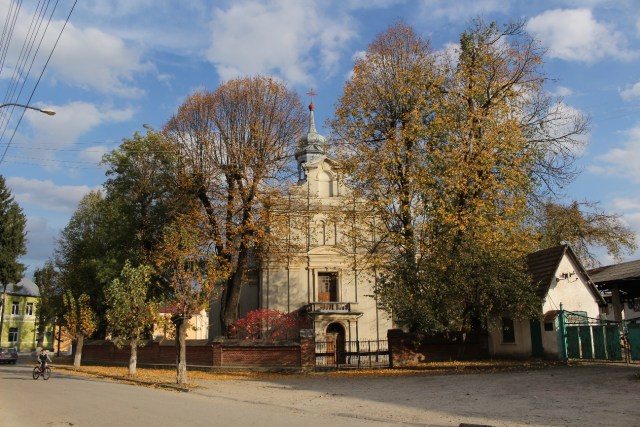
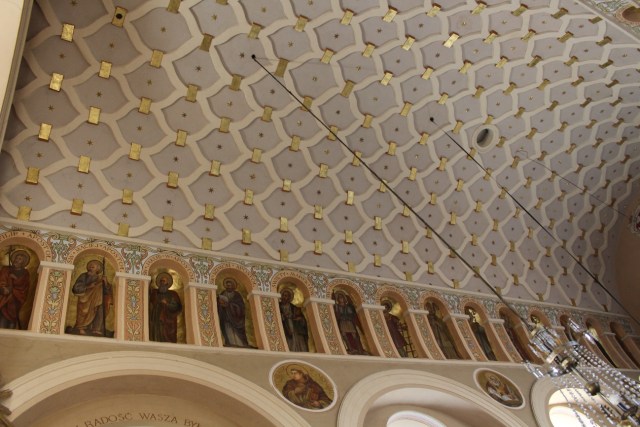
Until this church was built, the Catholics of Dobromyl went as far as the Church of St. Martin’s Church at Fulsztyn. Now it takes about 30 minutes by bus, so it must have been hard to go there on foot.
Fulsztyn is now known as the Skelivka village (though the old name is also on the bus stop sign), but the Herburt church and belfry, as well as the earthen walls for defense, remain. There used to be a splendid Mannerism-style altar inside the church, but it was destroyed by Russian troops during World War I. Russian troops raged in this area.
【Dobromyl Castle】
Around 1450, Mikołaj Herburt (-1447 or later) built a defensive wooden castle on Mt. Slipa, 4 kilometers south of the town. However, the castle was burned down in the 1497 attack by the Tatar.
Stanisław Herburt undertook the renovation of a stone and brick renaissance-style castle. Part of the walls and towers of this castle still remain, and it is known today as the tallest castle in the state of Lviv (560 meters above sea level). It seems to be crowded with hikers, tourists and people who want to have barbecues during the warmer seasons. To reach the mountain, you have to either go through the soybean fields via St. Onuphrius Monastery, or climb from the neighboring village of Ternawa (Тернава).
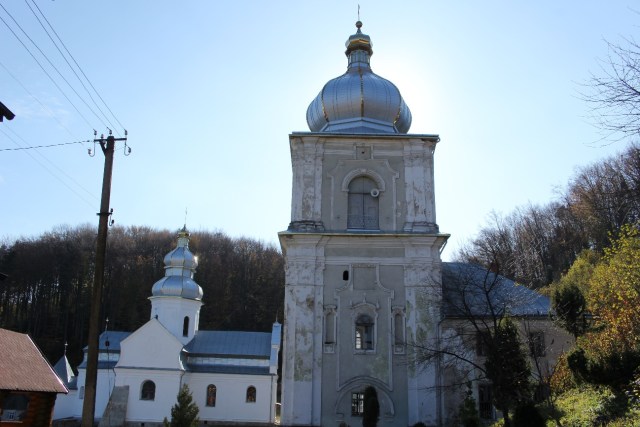
In the midst of Dobromyl, there was another castle called the “lower castle”. Today, the stone walls surrounding the castle building remain, and a roof has been installed for preservation. A three-year project from this year to 2021 is underway to restore the abandoned arsenal.
It is thought that the “upper castle” at the top of the mountain was used as the main defensive fort, and the “lower castle” was used as a residence during peacetime. This is similar to the “upper castle” and “lower castle” in Lviv.
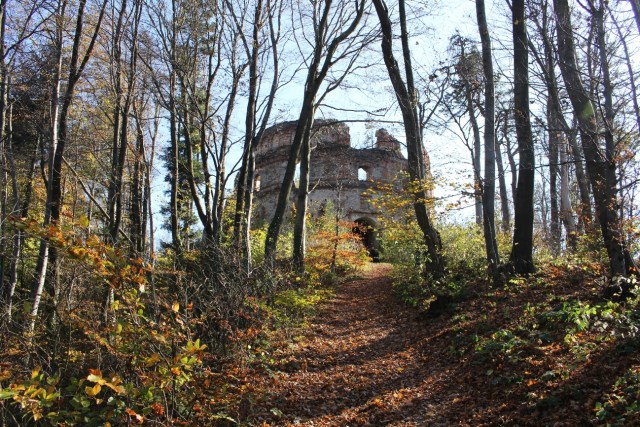
【Ukrainian Renaissance】
It can be said that Dobromyl flourished the most during the time of Jan Szczęsny (Feliks) Herburt (1567 – 1616). This Renaissance man, who studied in the West and played a central role in the opening of the Zamojski Academy, called himself “Ruthenian” (= Ukrainian) . He is known as a man who fought to protect the rights of the Ruthenian people.
He is quoted as having said,
“When the noble Ruthenians, whose blood runs through the veins of both my wife and I, suffer, I would stand with God’s help, as I was taught to do by right. (…) I would spare my power and life for any infringement of rights, and so I would not be delayed in putting it on the side of such a noble people, the people with whom I share my blood, who are now being deprived of their rights.”
This pride and trust in his people is not unique to him alone, but can be seen in many Ukrainians of this period. However, it seems particularly interesting that Herburt, who was originally of German descent, united himself with Ukraine.
Believing that education and learning were vital to the prosperity of society, he invited Jan Szeliga (-1636), a renowned printing engineer, to open the Dobromyl printing press to enhance the learning and dissemination of information among the Ruthenian people. The site is, due to modern administrative districts, in the neighboring village of Bonevich (a monument was recently built.).
His wife was Princess Yelyzaveta (-1618), an Orthodox daughter of the Zaslawski family, a branch of the Ostrogski family that created the cultural center of Ukraine.
Therefore, since the of the Dobromyl printing house, “Herburt’s Columns”, has the family crest of the Zaslawski family – the same family crest as the Ostrogski family -, as well as the family crest of Herburt, it symbolizes that the printing house inherits the spirit of the Ostrogski family.
The printing house’s motto was “truth and work” (“truth” can also be translated as “justice” and “work” as “works”). Many books that had a great influence on posterity had their first print here, including “Annales Polonici ab excessu Divi Sigismundi Primi” (Polish Chronicles from the Death of Sigismund the First) by Stanislaw Orzechowki (1513-1566), a Ruthenian author, and “Annales seu cronicae incliti Regni Poloniae” (Annals or Chronicles of the Famous Kingdom of Poland) by Jan Długosz (1415-1480).
The couple also opened the St. Onuphrius Monastery at the foot of Mt. Chernecha, which sits between the city and “upper castle”.
This site is known as the place where Andrey Sheptytsky (1865 – 1944), the future Patriarch of the Ukrainian Greek and Catholic Churches, started his religious life.
Jan Szczęsny ‘s sharp tongue was directed towards Sigismund III Vasa (1566 – 1632, reign 1587 – 1632), who was trying to impose Polonization on the Ruthenians, and the Society of Jesus that raised him. He used the Renaissance Paradox argument to openly criticize the king in “Zdanie o narodzie Ruskim” (A Note about the Ruthenian People, 1613).
“I know, let the local assembly have hope, and make them the joke of the national assembly. Promise the local assembly, and disregard them at the national assembly. Call them brethren at the local assembly, and apostates at the national assembly. (…) No matter what you think, there is no point. For in Rus, there is nothing that is impossible for Ruthenians, and if there were, it would be like wishing for the sea in Sambir, or the mountains of Bieszczady in Gdansk. (…) What if someone wanted Poles to stop being Poles in Poland? It is ridiculous! It cannot be done. That would mean forgetting how to speak Polish, and forgetting Polish law and customs.”
Jan Szczęsny also composed poetry in Ukrainian. Below is one such example:
|
Pastusze, pastusze, Liubliu tie do dusze, A sczo mene boli, Skazu ty do woli. Czeredoiku maiesz, Riadit iei nie znaiesz: Tobie z neiu licho, Iei z tobu nie tycho. Bywał tu didoiko, Mił się choroszeiko; Wołki się boiały Czeredu miiały. Da scoz nam czynity? Terpity, terpity, Z Bohem się nie bity. |
牧人よ、牧人よ、/ Shepherd, Shepherd 我れ汝(な)を心に思う、/ I think of you, 我れを苛むことを、/ To torment you, 汝れに有様(ありよう)に聞かせよう。/ I will let you be. 汝れ家畜を持てど、/You have livestock, 調和(あや)なすことままならず。/ Harmony does not remain. 汝れ家畜と災禍あり、/ You have livestock and calamity, 家畜汝れと寛ぎなし。/ Livestock without ease. 老人(おいびと)ここにありけり、/ The old man is here, つつがなく暮らしにけり。/ Living in good health. 狼どもは怖気づき、/ The wolves became scared, 家畜を避けて通りけり。/ Passing by and avoiding the livestock. されど我らにいかがはせん? / But how about us? 耐えて、耐えて、/ Endure, endure 神と争うことなかれ。/ Do not fight with god. |
Here, Zygmunt I (1467-1548, reign 1507-1548), known as “the old king” is contrasted with Sigismund III Vasa, and the latter is ridiculed. Is the wolf a Jesuit? Culturalists of this period preferred to hide the true meaning and use double meaning, so try solving the riddles hidden in the poem.
Jan Szczęsny conspired with his relative Mikołaj Zebrzydowski (1553-1620) and others to take up arms and fight the king, so his printing house was ordered to shut down, his publications were seized, and only a huge debt remained. The family line died out in his son’s time, and Dobromyl became the territory of the Koniecpolski family.
【Reference Links】
Добромиль // Замки і храми України [https://castles.com.ua/dobromyl.html] (最終閲覧日:原稿作成日、以下同じ)。
Скелівка // Там само [https://castles.com.ua/skeliwka.html].
Українська поезія XVII століття (перша половина) / упоряд., вступ. ст. та прим. В. В. Яременка; редкол.: І. Ф. Драч та ін. Київ: Рад. письменник, 1988. С. 43. [http://irbis-nbuv.gov.ua/cgi-bin/ua/elib.exe?
Z21ID=&I21DBN=UKRLIB&P21DBN=UKRLIB&S21STN=1&S21REF=10&S21FMT=online_book&C21COM=S&S21CNR=20&S21P01=0&S21P02=0&S21P03=FF=&S21STR=ukr0002048]. (1つ目の引用元)
Herburt J. S. Zdanie o narodzie Ruskim // Lipiński W. Z dziejów Ukrainy. Księga pamiątkowa ku czci Włodzimierza Antonowicza, Paulina Święcickiego i Tadeusza Rylskiego. Kijów, 1912. S. 92–97. (2つ目の引用元はS. 92–93、S. 80–92に解説)
Возняк М. Українські пісні в польських виданнях XVII ст. [Електронна копія]: (відбитка з ”Записок Наукового Товариства імені Шевченка”, т. CLC). Львів, 1937. С. 4. [https://elib.nlu.org.ua/object.html?id=3277]. (歌の引用元)
Długosz J. Historia Polonica Ioannis Długossi […] In Tres Tomos Digesta Autoritate et Sumptibus Herbulti Dobromilski edita. [T. 1]. Dobromili, 1615. [https://www.dbc.wroc.pl/dlibra/doccontent?id=8014&from=FBC]. (ドブローメィリ版『ドウゴシュの年代記』。ドブローメィリ印刷所の紋あり)
Пагутяк Г. Український вірш із ХVІІ століття. Слово Просвіти. 23. Київ, 2013. С. 13.
October Activity Report
31 October 2019
Global Japan Office Coordinator
HARA Masaki
At the end of September, our exchange students returned to Japan, after which Lviv was temporarily cold, with temperatures falling below zero. After that, the weather was nice and warm for about half of October, but it got cold again by the end of the month. The leaves of the trees have faded and are now looking like winter in Tokyo.
Anyway, there were many Japan-related events held this October.
【Lecture by Author TSUJIHARA Noboru】
On October 9, Mr. Tsujihara Noboru, a writer from Japan, held a lecture at Lviv University as he traveled around Ukraine. On the day of the event, the large classroom was filled with an audience of Japanese department students and teachers.
Mr. Tsujihara has been fascinated by Gogol’s works since he was young, and was very much looking forward to his first visit to Ukraine. After Lviv, he plans to visit Kyiv (Qiu) and Gogol’s hometown, Portava.
Mr. Tsujihara also spoke his praises for ‘Don Quixote’ and ‘The Tale of Genji’ and said that the former encompasses all the possibilities of a novel, and should be read by students (as they are Japanese language students, ‘The Tale of Genji’ was also recommended). He also suggested that a fusion of ‘Don Quixote’ and ‘The Tale of Genji’ could lead to an interesting novel.
The audience asked many questions. When asked about his motives for becoming a writer, Mr. Tsujihara replied that motives for writing novels were unknown to writers themselves, and likened the process to love. He also said that literature is not something that is written “for the sake of something”.
He said that the reason why so many of his works use foreign countries as a setting is that the story (and its characters) cannot remain within the framework of Japan, and that there is a need for a space to move freely. He also said that his works are set in specific historical periods because it is interesting to think about what people thought and how they loved each other 1000 years ago, and that he wants to surpass the European idea of absolute time.
Mr. Tsujihara discussed how a novel is basically a fantasy, but what supports this fantasy is the power of refined writing, and so it is important that the writing itself is accurate. In that sense, he also said that he wants to tell the “perfect lie”.
As Mr. Tsujihara’s visit was just before the enthronement ceremony, he also touched on this, and told an anecdote of how Empress Emerita Michiko recommended his novel “Yurusarezaru Mono”, a novel about the High Treason Incident, to the Crown Prince (current Emperor).
The Japanese department at Lviv University is in the Faculty of Letters, and many students are interested in literature, so I think they were able to listen with great interest (I think the number of questions demonstrated that). Unfortunately, it is difficult to obtain Noboru Tsujihara’s work in Ukraine, so there were no students who had read his work (there are no Ukrainian translations), but I thought that reading his work would make what they heard in his lecture more practical and concrete.
I hope Mr. Tsujihara enjoys Ukraine.
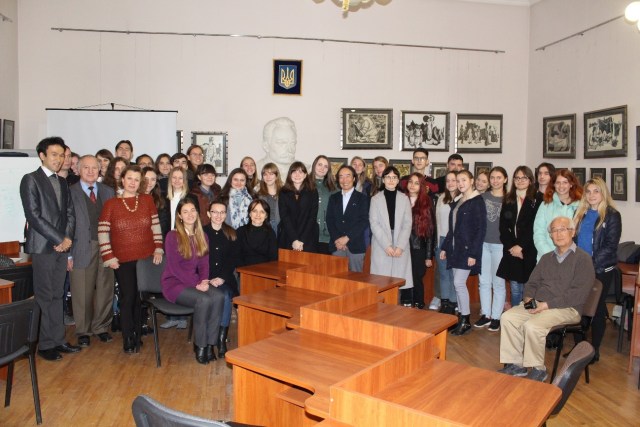
【Speech Contest】
On October 19, the 24th Japanese Speech Contest was held at Kyiv National Language University. Third-year student Inna Stokratna from the University of Lviv gave a speech on “Childish People”. Inna argued that the world would become more gentle and free if we could use the word “childish” to mean children’s curiosity, fresh sensitivity, and the courage to not be afraid of the unknown, instead of as its current usage meaning “irresponsible” or “moody person”.
Inna has been practicing her speech since before the summer vacation, and as a result, she took fourth place in the whole country. I think she practiced well every day, because she improved noticeably from September to October. In addition, our homeroom teacher, Ms. Ulyana, and all her classmates actively helped her with the Q & A practice. Congratulations on winning.
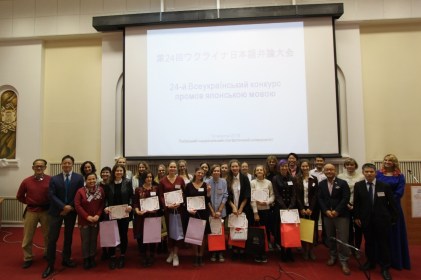
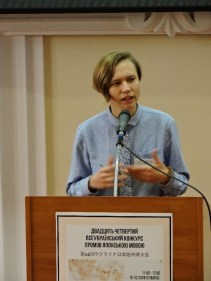
【Japanese Drum and Shakuhachi Concert】
On October 22, to coincide with the enthronement ceremony of the new Emperor, a concert of Japanese drums and shakuhachi (bamboo flute) was held by the Japanese Embassy at the Maria Zankovetska National Academic Ukrainian Drama Theater (Lesia Ukrainka street, 1, Lviv). This concert was held only in Lviv. Prior to the concert, Ambassador Takashi Kurai gave a speech in Ukrainian, which was very impressive.
Taniguchi Takuya, a Japanese drum player, and Obama Akihito, a shakuhachi player, performed traditional and original music. I was overwhelmed by the powerful performance. They also explained the instruments to the audience who had never seen them before.
Many Japanese department students and teachers from Lviv University also went to listen, so I think it was interesting. Personally, I like the Dengaku (ritual music) performance the best.
The fact that this event was held in Lviv (which is not the capital) was something done out of consideration to allow a wider range of Ukrainians to experience Japanese culture, and I hope that interesting events will continue to be held in various parts of Ukraine.
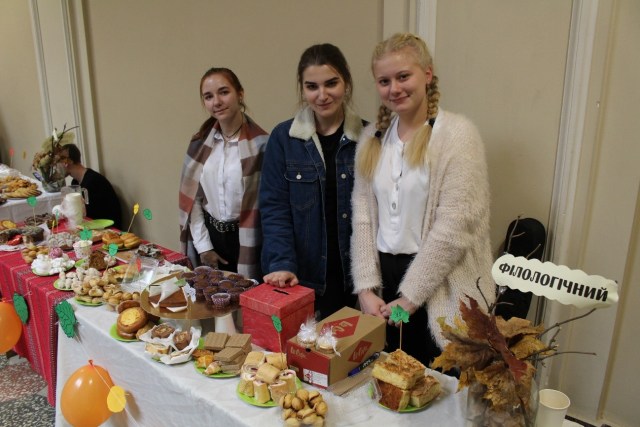
【Reference Links】
「倉井大使夫妻 第24回ウクライナ日本語弁論大会に出席」在ウクライナ日本国大使館ホームページ(原稿作成日閲覧、以下同じ)。
https://www.ua.emb-japan.go.jp/itpr_ja/00_001521.html
「倉井大使夫妻 和太鼓・尺八コンサートを開催」同上
https://www.ua.emb-japan.go.jp/itprtop_ja/00_001524.html
同コンサートに関するリヴィウ市議会の記事
https://city-adm.lviv.ua/news/culture/272015-lviv-pryimav-kontsert-iaponskoi-muzyky-za-uchastiu-inozemnykh-muzykantiv
September Activity Report
30 September 2019
Global Japan Office Coordinator
HARA Masaki
【Summer School】
This year, as in previous years, four exchange students came to Lviv University to participate in the three-week Summer School program held for international exchange students from the start of September. This year’s participants were SANO Tomohito, TANOUE Rintaro, TOYOSHIMA Aiko and SHIMOMURA Rio. Their majors are Chinese, Mongolian and Russian, so they are a really diverse lineup.
Aside from the main subject of Summer School, Ukrainian language, there are also classes on Ukrainian culture and history, Ukrainian literature and Ukrainian etymology. In addition to this, traditional “motanka” doll-making classes and Ukrainian home cooking workshops were held. Students also observed a course taught at the Centre for Culture and Creativity for Children and Youth in Halychyna (Galicia). On the weekends, the students travelled around Ukraine and its neighboring countries, and it seems they even explored and did sightseeing locally in Lviv.
While the students did encounter a few troubles during their stay, they were able to finish the program without a hitch. On the last day, the students were awarded one by one with a completion certificate by the Dean of the Faculty of Philology, Svyatoslav Pylypchuk.
Students majoring in Japanese at Lviv University were also pleased to meet the Japanese exchange students.
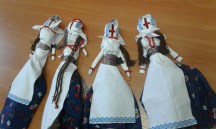
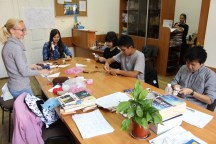
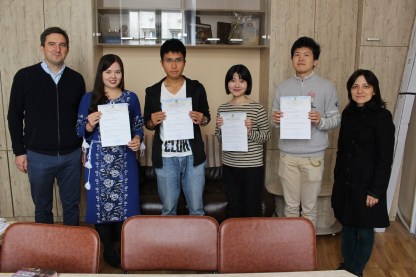
【Book Market】
This year, the 26th Book Forum, a book market held every year, was held from September 18-22. The market was mainly held on the grounds of the Lviv Art Palace and the Potocki Palace next door, but there were many other venues around the city (30 according to the Book Forum website).
This event is always bustling with people, as not only do publishers from neighboring countries gather here, but the books themselves are also sold at a lower price than usual. Despite the Ukrainian publishing industry being in a bit of a predicament due to the internet (libraries in Ukraine have actually decreased their opening hours due to lack of visitors), this event makes it seem like many people still enjoy reading books.
I also noticed that children’s books (picture books etc.) have been performing strongly over the years, and the designs have become cuter and cuter (this may just be my personal opinion though). I think that the once-popular soviet style of design (perhaps this is called Russian style?) has fell out of fashion and been replaced by a more local Lviv-inspired style. The children’s books were spread out across a rather large space, and there were many publishers who seemed to specialize in them. I also heard that most Ukrainian adults don’t read books, but buy them for their children.
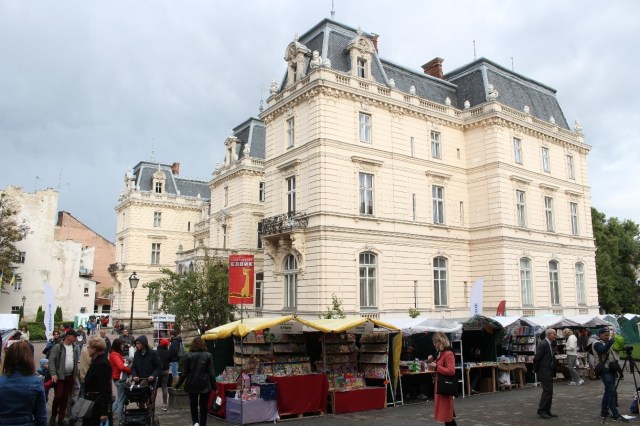
【Reference Links】
26th Book Forum Website (2019年9月30日閲覧).
https://bookforum.ua/forum-vydavtsiv/
